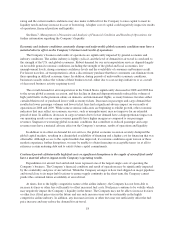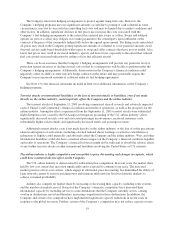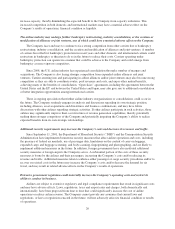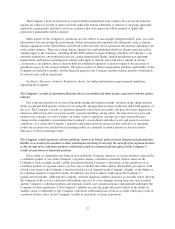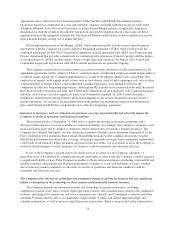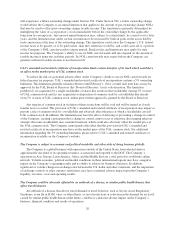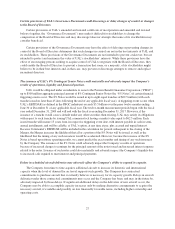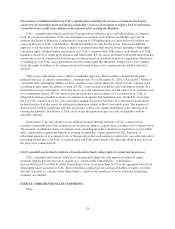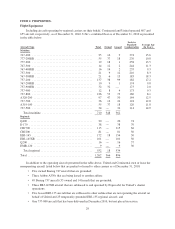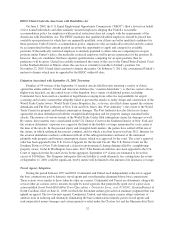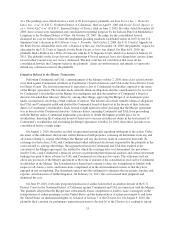United Airlines 2010 Annual Report Download - page 28
Download and view the complete annual report
Please find page 28 of the 2010 United Airlines annual report below. You can navigate through the pages in the report by either clicking on the pages listed below, or by using the keyword search tool below to find specific information within the annual report.will experience a future ownership change under Section 382. Under Section 382, a future ownership change
would subject the Company to an annual limitation that applies to the amount of pre-ownership change NOLs
that may be used to offset post-ownership change taxable income. This limitation is generally determined by
multiplying the value of a corporation’s stock immediately before the ownership change by the applicable
long-term tax-exempt rate. Any unused annual limitation may, subject to certain limits, be carried over to later
years, and the limitation may under certain circumstances be increased by built-in gains in the assets held by
such corporation at the time of the ownership change. This limitation could cause the Company’s U.S. federal
income taxes to be greater, or to be paid earlier, than they otherwise would be, and could cause all or a portion
of the Company’s NOL carryforwards to expire unused. Similar rules and limitations may apply for state
income tax purposes. The Company’s ability to use its NOL carryforwards will also depend on the amount of
taxable income it generates in future periods. Its NOL carryforwards may expire before the Company can
generate sufficient taxable income to use them in full.
UAL’s amended and restated certificate of incorporation limits certain transfers of its stock which could have
an effect on the market price of UAL common stock.
To reduce the risk of a potential adverse effect on the Company’s ability to use its NOL carryforwards for
federal income tax purposes, UAL’s amended and restated certificate of incorporation contains a 5% ownership
limitation. This limitation generally remains effective until February 1, 2014, or until such later date as may be
approved by the UAL Board of Directors (the “Board of Directors”) in its sole discretion. The limitation
prohibits (i) an acquisition by a single stockholder of shares that results in that stockholder owning 5% or more
of UAL common stock and (ii) any acquisition or disposition of common stock by a stockholder that already
owns 5% or more of UAL common stock, unless prior written approval is granted by the Board of Directors.
Any transfer of common stock in violation of these restrictions will be void and will be treated as if such
transfer never occurred. This provision of UAL’s amended and restated certificate of incorporation may impair or
prevent a sale of common stock by a stockholder and adversely affect the price at which a stockholder can sell
UAL common stock. In addition, this limitation may have the effect of delaying or preventing a change in control
of the Company, creating a perception that a change in control cannot occur or otherwise discouraging takeover
attempts that some stockholders may consider beneficial, which could also adversely affect the market price of
the UAL common stock. The Company cannot predict the effect that this provision in UAL’s amended and
restated certificate of incorporation may have on the market price of the UAL common stock. For additional
information regarding the 5% ownership limitation, please refer to UAL’s amended and restated certificate of
incorporation available on the Company’s website.
The Company is subject to economic and political instability and other risks of doing business globally.
The Company is a global business with operations outside of the United States from which it derives
approximately one-third of its operating revenues, as measured and reported to the DOT. The Company’s
operations in Asia, Europe, Latin America, Africa and the Middle East are a vital part of its worldwide airline
network. Volatile economic, political and market conditions in these international regions may have a negative
impact on the Company’s operating results and its ability to achieve its business objectives. In addition,
significant or volatile changes in exchange rates between the U.S. dollar and other currencies, and the imposition
of exchange controls or other currency restrictions, may have a material adverse impact upon the Company’s
liquidity, revenues, costs and operating results.
The Company could be adversely affected by an outbreak of a disease, or similar public health threats, that
affect travel behavior.
An outbreak of a disease that affects travel demand or travel behavior, such as Severe Acute Respiratory
Syndrome, avian flu or H1N1 virus, or other illness, or travel restrictions or reduction in the demand for air travel
caused by similar public health threats in the future, could have a material adverse impact on the Company’s
business, financial condition and results of operations.
26




